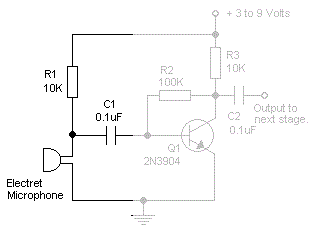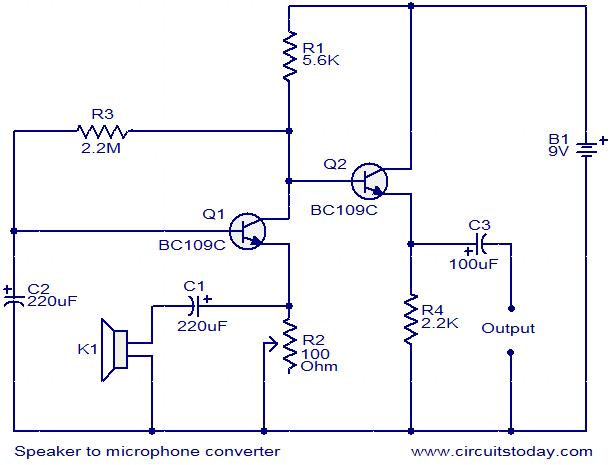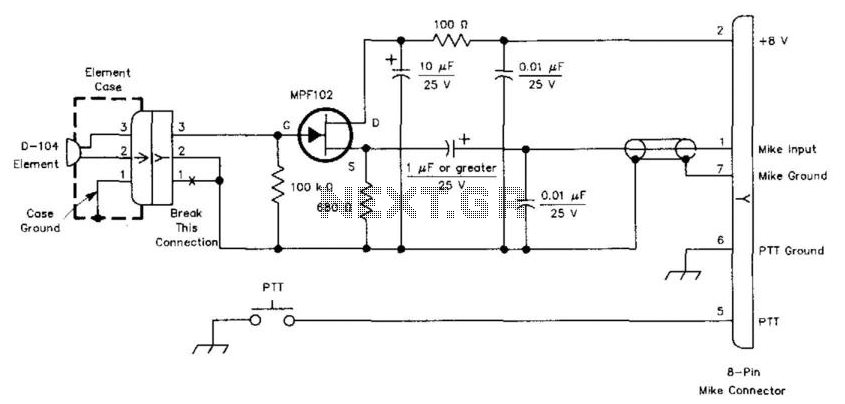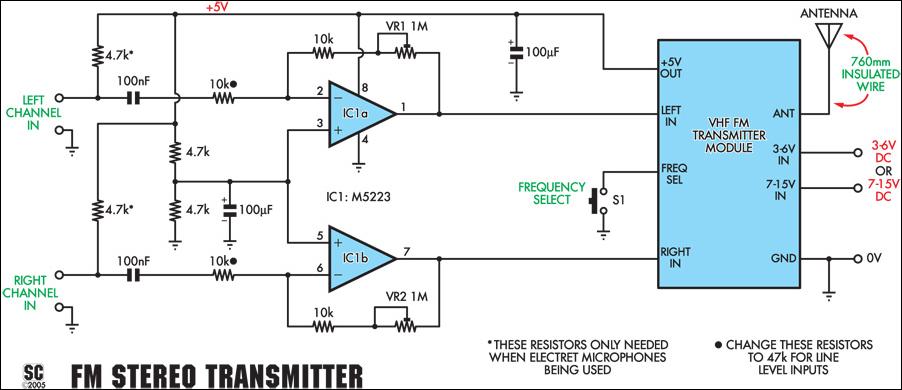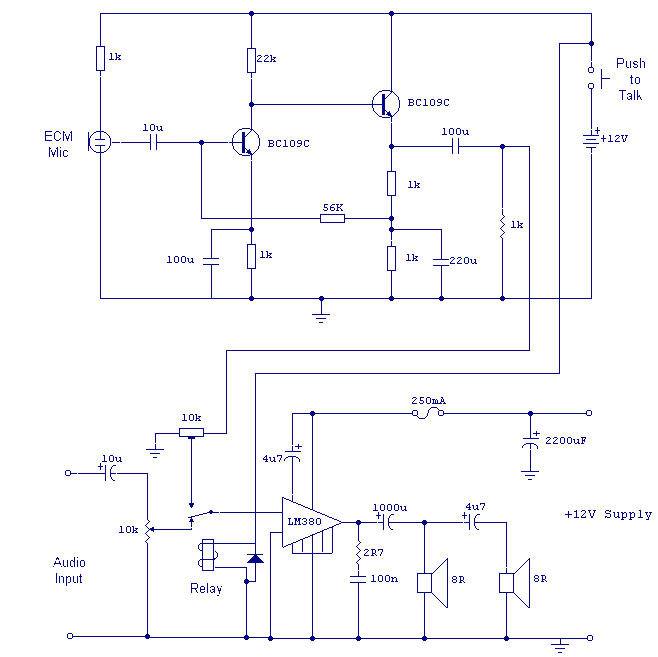
Loudspeaker as a Microphone

This circuit allows you to use a cheap loudspeaker as a microphone. Sound waves reaching the speaker cone cause fluctuations in the voice coil. The voice coil moving in the speaker's magnetic field will produce a small electrical signal.
The circuit is designed to be used with an operating voltage between 6 and 12 volts DC. The first transistor operates in common base mode. This has the advantage of matching the low input impedance of the speaker to the common base stage, and secondly has a high voltage gain. The second stage is direct coupled and operates in emitter follower. Voltage gain is slightly less than unity, but output impedance is low, and will drive long cables.
Speech quality is not as good compared to an ordinary or ECM microphone, but quite adequate for basic applications.
This circuit utilizes a loudspeaker as a makeshift microphone, capitalizing on the principle that sound waves can induce a small electrical signal in a voice coil. The circuit operates effectively within a voltage range of 6 to 12 volts DC, making it suitable for various low-power applications.
The first stage employs a transistor configured in common base mode. This configuration is particularly advantageous for interfacing with the loudspeaker, as it provides a good match for the low input impedance of the speaker. The common base mode also offers a significant voltage gain, enhancing the weak electrical signal generated by the speaker.
Following the initial amplification stage, the circuit features a second transistor configured as an emitter follower. This configuration is characterized by a voltage gain that is slightly less than unity, which implies that while the output voltage is approximately the same as the input voltage, the output impedance is significantly reduced. This low output impedance is crucial as it allows the circuit to effectively drive long cables without significant signal degradation.
Although the speech quality achieved with this circuit may not match that of conventional microphones or electret condenser microphones (ECMs), it remains acceptable for basic audio capture tasks. The simplicity and low cost of this circuit make it an appealing option for applications where high fidelity is not paramount. Overall, this circuit design exemplifies a practical approach to utilizing readily available components for audio signal capture. This circuits allows you to use a cheap loudspeaker as a microphone. Sound waves reaching the speaker cone cause fluctuations in the voice coil. The voice coil moving in the speakers magnetic field will produce a small electrical signal. The circuit is designed to be used with an operating voltage between 6 and 12 volts dc. The first transistor operates in common base mode. This has the advantage of matching the low input impedance of the speaker to the common base stage, and secondly has a high voltage gain. The second stage is direct coupled and operates in emitter follower. Voltage gain is slightly less than unity, but output impedance is low, and will drive long cables. Speech quality is not as good compared to an ordinary or ECM microphone, but quite a 🔗 External reference
The circuit is designed to be used with an operating voltage between 6 and 12 volts DC. The first transistor operates in common base mode. This has the advantage of matching the low input impedance of the speaker to the common base stage, and secondly has a high voltage gain. The second stage is direct coupled and operates in emitter follower. Voltage gain is slightly less than unity, but output impedance is low, and will drive long cables.
Speech quality is not as good compared to an ordinary or ECM microphone, but quite adequate for basic applications.
This circuit utilizes a loudspeaker as a makeshift microphone, capitalizing on the principle that sound waves can induce a small electrical signal in a voice coil. The circuit operates effectively within a voltage range of 6 to 12 volts DC, making it suitable for various low-power applications.
The first stage employs a transistor configured in common base mode. This configuration is particularly advantageous for interfacing with the loudspeaker, as it provides a good match for the low input impedance of the speaker. The common base mode also offers a significant voltage gain, enhancing the weak electrical signal generated by the speaker.
Following the initial amplification stage, the circuit features a second transistor configured as an emitter follower. This configuration is characterized by a voltage gain that is slightly less than unity, which implies that while the output voltage is approximately the same as the input voltage, the output impedance is significantly reduced. This low output impedance is crucial as it allows the circuit to effectively drive long cables without significant signal degradation.
Although the speech quality achieved with this circuit may not match that of conventional microphones or electret condenser microphones (ECMs), it remains acceptable for basic audio capture tasks. The simplicity and low cost of this circuit make it an appealing option for applications where high fidelity is not paramount. Overall, this circuit design exemplifies a practical approach to utilizing readily available components for audio signal capture. This circuits allows you to use a cheap loudspeaker as a microphone. Sound waves reaching the speaker cone cause fluctuations in the voice coil. The voice coil moving in the speakers magnetic field will produce a small electrical signal. The circuit is designed to be used with an operating voltage between 6 and 12 volts dc. The first transistor operates in common base mode. This has the advantage of matching the low input impedance of the speaker to the common base stage, and secondly has a high voltage gain. The second stage is direct coupled and operates in emitter follower. Voltage gain is slightly less than unity, but output impedance is low, and will drive long cables. Speech quality is not as good compared to an ordinary or ECM microphone, but quite a 🔗 External reference
